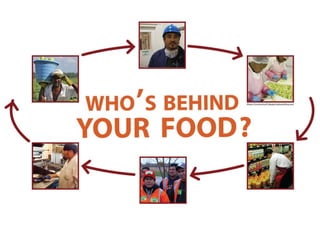
Racial pay gap in restaurant work highlighted
- 4. Photo from NY Times
- 5. Photo by Scott Robertson
- 9. From “The Color of Food” by the Applied Research Center
- 10. From “The Color of Food” by the Applied Research Center
Notes de l'éditeur
- So I’m going to give you a very brief overview of the people working in our food system and ways in which institutional purchasing and consumer pressure have helped to improve the situation of food system workers. Over 20 million people in the U.S. and hundreds of millions more around the world work in the food system, which historically was built on slave and indentured labor and continues to be subsidized by the exploited labor of low-wage workers, most of whom are people of color and immigrants.
- The food system around the world was historically built on slave and indentured labor.
- After the Civil War, African-American sharecroppers in the South and Asian immigrants in the West became the low-paid workforce in the food system. Then, in the latter part of the nineteenth and early twentieth centuries, many aspects of food production were sustained by a labor force composed of recent Asian and Eastern European immigrants who were considered ethnically distinct from what was culturally defined as mainstream white America, and later, these same food-processing facilities hired African-American workers, often on a temporary basis as strikebreakers.
- In the middle of the 20 th century, Mexican braceros were brought to the United States to work in the agricultural fields, a trend which continues in the present day with undocumented immigrant workers serving as the primary laborers in our fields and throughout much of the food system.
- In the U.S. and around the world, many food workers are excluded from basic labor protections. Due to the historical legacy of slavery and racism in the U.S., farmworkers are not covered under the National Labor Relations Act, which gives workers the right to organize collectively and to form a union. Farmworkers are also not protected by overtime provisions of the Fair Labor Standards Act.
- The federal minimum wage for restaurant and other tipped workers is $2.13 per hour while the federal minimum wage is $7.25. This rate of $2.13 has not increased in over 20 years. And undocumented workers, who account for an estimated 39% of food workers in the U.S., are not afforded the same remedies for violations of their right to organize as documented workers are.
- Overall, food workers are often the most abused workers in the U.S. and around the world suffering from extremely low wages, no job security, and the difficulty of organizing. Many undocumented immigrant workers are afraid to even ask for the minimum wage, which they have a right to under the law, because their employers, directly or indirectly, threaten to report them to the government and have them deported.
- Here’s a handout about the wages and working conditions of food workers. So I won’t go into specific statistics about workers in each segment of the food system. Overall, in the U.S. the median annual earnings of food workers is less than $22,000, less than the federal poverty level for a family of 4.
- And racism and gender discrimination are still rampant. In the U.S. people of color make lower wages than whites in the food chain, and more people of color live in poverty than white food workers.
- And women of all races make substantially less than white men in the food system.
- Family farmers and independent fisherfolk are also suffering under the current food system. In the 1930s there were close to seven million farmers in the U.S. Today, due to corporate consolidation in the food system and other factors, only two million remain and only one fourth of those farmers are able to support themselves on farm income alone. Similar corporate consolidation is now happening in the fisheries, such that independent fisherfolk are increasingly finding it difficult to make a living.
- So what can we do about the exploitation of workers, family farmers, and independent fisherfolk? Institutional purchasing and consumer pressure historically and in the present-day have been used to improve the situation of workers and family farmers. Farm to school programs are one example. For workers, many of you might recall the grape boycott led by the United Farm Workers union in the 1960s, which successfully pressured growers to recognize the UFW and negotiate union contracts that improved the wages and working conditions of farmworkers.
- More recently the Coalition of Immokalee Workers, a member of the FCWA, won their first victory in their Campaign for Fair Food for higher wages and better working conditions for tomato farmworkers in large part with the support of students who pressured their universities to kick Taco Bell off their campuses.
- The anti-sweatshop movement, which gained steam and momentum after 72 Thai garment workers were found in modern slavery sewing for major retailers in El Monte, California, has made many gains using institutional purchasing policies to benefit garment workers. The United Students Against Sweatshops has gotten 180 colleges and universities to sign on to the Workers Rights Consortium code of conduct to ensure that college-logoed apparel is produced in factories that respect basic workers’ rights.
- And the sweatfree movement, led by Sweatfree Communities, has been extremely successful in winning 191 policies for responsible procurement of apparel in cities, states, and school districts around the U.S. And 3 states and 10 cities, including Portland, Oregon, have joined together in the Sweatfree Purchasing Consortium to coordinate their efforts and promote similar sweatfree initiatives among other governmental entities.
- So now our hope is that we can win similar responsible purchasing policies for food, but combine them with local or regional purchasing preferences. Ryan will now talk more about fair trade…
